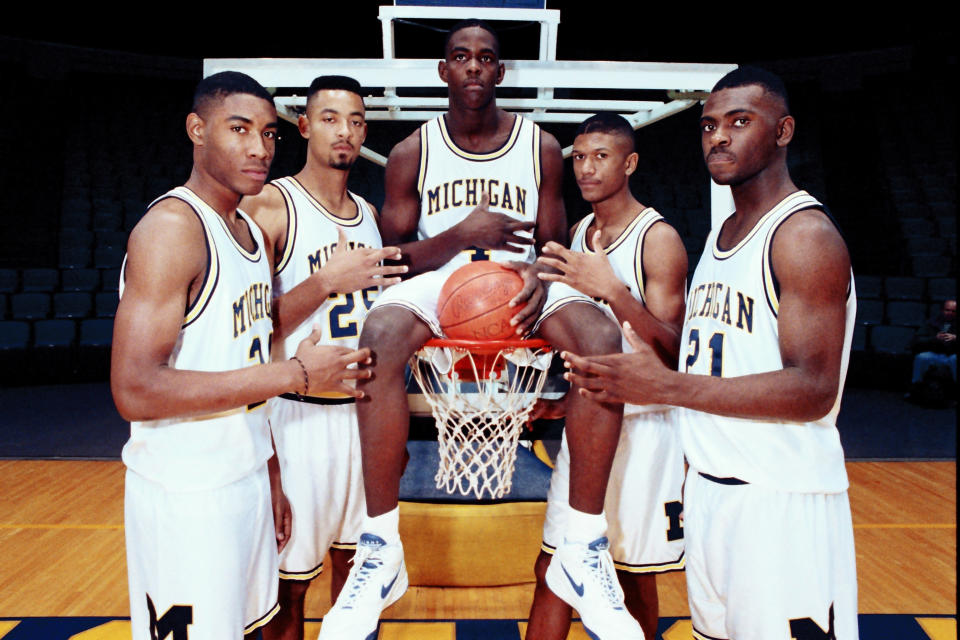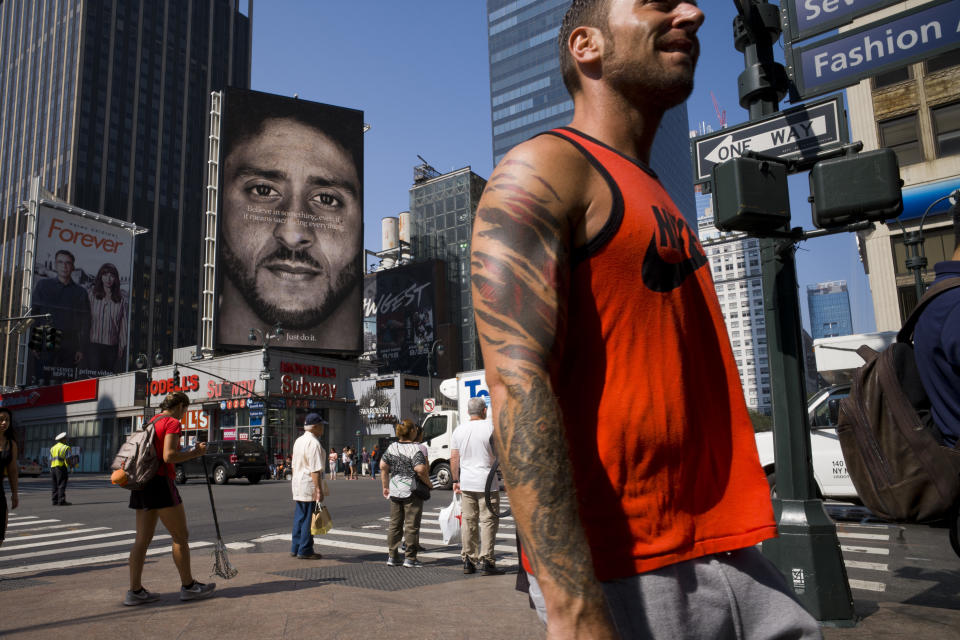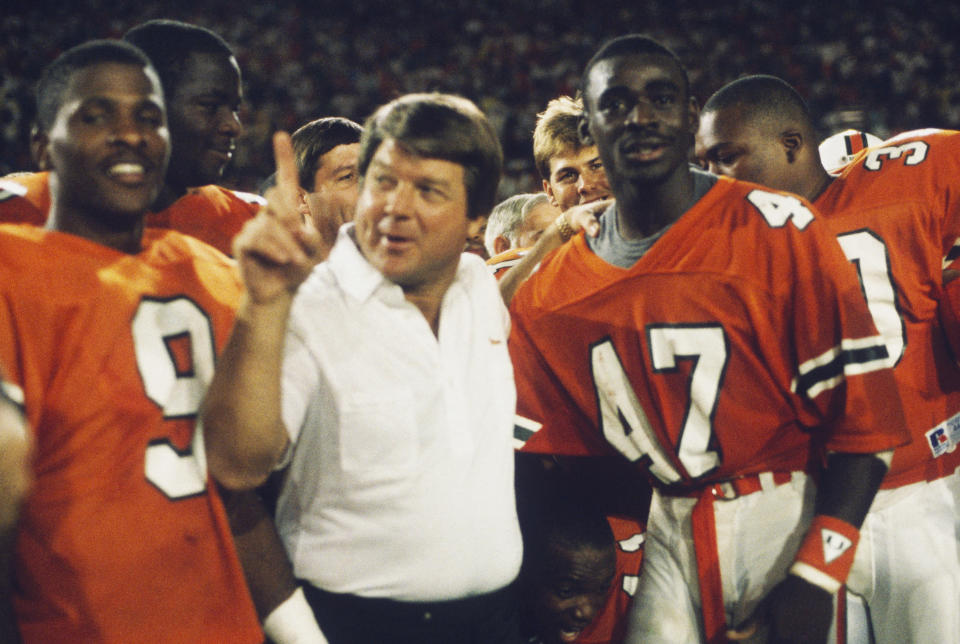From Fab Five to Colin Kaepernick, this is how Nike grabs the audience that embraces rebels
Do you remember your first sports crush? You know, the players (or team) who made you realize you cared more about sports than Legos or drum sets or action figures?
For me, it was the Fab Five, and man, did that end up costing me money down the line. To understand why it did, I need you to come back with me to 1993.
I was 9 years old then, a Detroit kid through and through, and I immediately took to those basketball players. It was instinctive. Here were five young black guys, not all that much older than me, who were good at what they did — they were sophomores by then, so they’d been winning for over a year — and looked cool doing it.
The bald heads. The ankle socks. The swagger, the on-court jabber. And two of them — Jalen Rose and Chris Webber — were from my city! In retrospect, I had no chance.

You know what else I dug because of the Fab Five? Nike. From the time Juwan, Jalen, Jimmy, Chris and Ray stepped on campus in Ann Arbor, the swoosh became as much a part of their identity as the baggy shorts. Both Nike and Michigan made sure of that, as they teamed up with sports apparel stores to hawk products so ruthlessly that Marlo Stansfield would be proud.
“You’ve dreamed of being one of the Fab Five. You’ve dreamed of racing down the Wolverines’ home court. You’ve dreamed of waltzing into Champs Sports and purchasing your own authentic maize and blue Michigan uniform,” stated a popular ad at the time, with Webber in full uniform to the side, rocking the gorgeous maize No. 4 jersey and black Air Force Maxes.
I dreamed of doing all those things, even buying what Webber was wearing in that ad. And I wasn’t alone, as teenagers from all walks of life pressured their parents to buy Fab Five gear at a rate that made it only slightly easier to find than Teenage Mutant Ninja Turtles action figures or Game Boys around Christmas.
In retrospect, I get how that group appealed to 9-year-old me. Kids love to rebel, and part of the Fab Five’s mythology was their overwhelming “us-against-the-world” factor. The bald heads were unusual, and so were the ankle socks and baggy shorts. Jalen had a tattoo, which made some writers uncomfortable back then, and in a sport dominated by the likes of basketball dictators like Bob Knight, five freshmen — specifically, five black freshmen— never started together.
So yeah, to youngsters across America, especially kids who looked like them, the Fab Five was cool as hell. And at some point in Nike’s history, the company realized that there’s big money to be made by associating its brand with any sports figure or institution that can tap into that. Maybe it even came from all the buzz Michael Jordan’s famed “banned” gym shoe generated in 1984.
In the mid-90s, Nike doubled down on the concept, as it not only found other schools with “rebel”-type programs — signing Michigan, the University of Miami’s football program and Georgetown’s basketball program all within a few years of each other — they also went out of their way to sponsor athletes with that attitude and reputation, like brash, future Hall of Famer Deion Sanders, for instance.
And guess what? Teenage Terez loved all those dudes. So by proxy, I grew to love Nike, and it’s an apparel preference that continues to this day. I own more Nike shoes than I care to admit — it’s a sickness, I know — and I overwhelmingly rock Nike sneakers and apparel over other athletic brands.

That, my friends, is the type of loyalty you can’t beat, and Nike — which has grown into a multibillion dollar company using this strategy — knows it, which is why it’s willing to go all-in on Colin Kaepernick as a long-term play. Shares of Nike hit an all-time high at Thursday’s closing of the stock market and Bloomberg News reported, “It will likely be months, if not longer, until anyone can fully measure the business impact of Nike Inc.’s controversial partnership with quarterback-turned-activist Colin Kaepernick, but early data from Edison Trends show sales tracking well above last year.”
The global giant has taken a short-term hit among some consumers thanks to its new endorsement deal with Kaepernick, whose decision to protest racism and police brutality during the national anthem two years ago remains as divisive an issue as the NFL has seen in years.
My colleague Charles Robinson reported in May that the NFL used a polling firm to canvas public opinion on Kaepernick’s decision to protest racism and police brutality during the national anthem, and the data showed that a majority of African-American and Latino fans — at an overwhelming clip — were against discipline of Kaepernick and other kneeling players, far more than a majority of white fans. The numbers also showed that Democrat, Generation Xer and millennial fans were far less likely than Republican and Baby Boomers to support discipline for protesting during the anthem.
All this has essentially led one side to hail Kaepernick as a hero, while the other views him as a villain. It’s the kind of divisive, racial thing that businesses tend to stray from, lest they alienate half their consumer base. Yet, Nike entered the Kaepernick fray, knowing the result would be burned shoes, mutilated socks and widespread promises to never purchase Nike again. And it didn’t do it because it supported his cause, they did it because for shoe companies, going young is the way to go.
Recent analysis conducted by Elasticity, a digital brand reputation management agency, suggests that most of the people engaged in the #BoycottNike movement are among those least likely to be part of Nike’s consumer base, something Nike surely knows all too well.
Remember when older fans raced to judge the Miami Hurricanes for dancing and dominating … when they scolded the Fab Five for jawing and winning … when they shook their heads at a tall, menacing, black coach, John Thompson, for giving an ex-convict named Allen Iverson a chance to play college ball … and hated Deion for high-stepping and locking opponents down … all of those same players were embraced by a much younger audience, many of whom still buy Nike’s products to this very day.
You know, like me.

And if the numbers the NFL harvested surrounding the Kaepernick issue are correct, it’s not hard to imagine Kaepernick’s new line — which calls for shoes, shirts, jerseys and apparel, all bearing his name — being very popular with millennials and Gen Xers, not just in the present, but for the foreseeable future.
Chances are, they won’t forget how Nike — not Adidas (which is gaining on Nike in America) — was the company that slapped its logo on the Kaepernick gear they’ll wear to make a statement in these divided political times.
What’s more, for black folks, specifically — who are overwhelmingly the contributors to (and consumers of) sneaker culture — it’s easy to imagine a future where the rocking of Kaepernick gear will also be an indication that you are indeed “woke” and someone who stands with the rebel.
And while Kaepernick is socially conscious, someone with a cause that goes deeper than the “how-dare-they?” undertones of the ’90s sports “villains” I grew up rooting for, the effect of his partnership with Nike could easily be similar to the wave that led many to rock black socks and baggy shorts, or anything with “Georgetown” or “Miami” across the front of it with the Nike swoosh, for example.
For Nike, of course, all of this could add up to lots of cash as it seeks to re-establish brand loyalty among young consumers and cement its status as the dominant sneaker leader in America by supporting the rebel Kaepernick.
And if you want proof of whether that strategy worked in the past … all you have to do is take a look at my closet.
Subscribe to The Yahoo Sports NFL Podcast
Apple Podcasts• Stitcher • Google Podcasts
More from Yahoo Sports:
• Naomi Osaka reveals what Serena told her while fans booed at U.S. Open
• Mayor lifts Nike ban in Louisiana town following outcry
• Jags coach gets too ‘pissed off’ to watch Super Bowl
• Antonio Brown apologizes to reporter after sending threatening tweet

